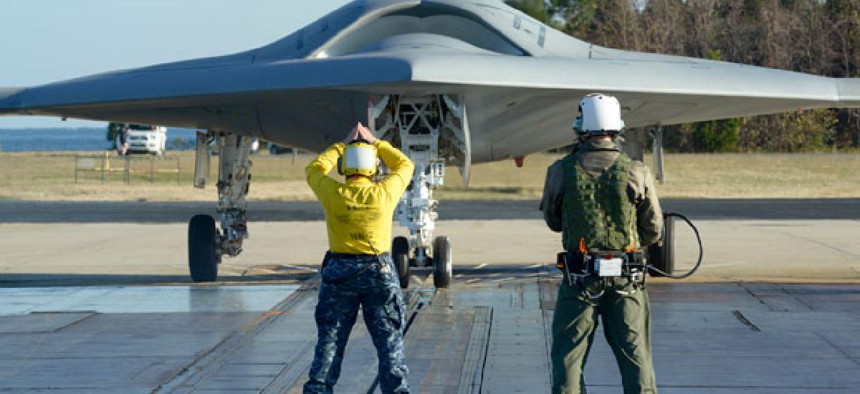Autonomous drone poses no technology challenges for Navy, official says

Northrop Grumman
The X-47B flies on 3.5 million lines of software code.
The Navy has not found technology challenges in developing the Northrop Grumman X-47B unmanned combat air system aircraft, Capt. Jaime Engdahl, program manager for the system, told a press briefing Friday.
Designed to fly autonomously without a ground-based pilot, unlike drones such as the Air Force’s Predator, the X-47 successfully completed its first catapult launch Thursday from the Naval Air Station in Patuxent River, Md. The craft then flew and landed back at the base, said Carl Johnson, the Northrop Grumman program manager.
The Navy loaded the second X-47B demonstrator on the Norfolk, Va.-based USS Harry Truman aircraft carrier on Tuesday for flight deck test operations. A catapult launch and flight test for the unmanned aircraft from an East Coast-based carrier is slated for the summer of 2013.
The Navy last year conducted flight tests of the X-47B at Edwards Air Force Base, Calif., transported the drone to Patuxent River this year and ran a successful 36-minute flight test in July over the Chesapeake Bay.
In addition to these live tests, Navy and Northrop Grumman officials said the X-47B has flown thousands of flights in a computer simulation lab, and Engdahl said that the service “has not found any technology challenges” through any stages of flight, including launch, simulated aerial refueling and landing.
Mike Mackey, another Northrop Grumman program director, said the aircraft is managed by 3.5 million lines of software code. Engdahl said this software digitizes the view a pilot would have for flight operations, including carrier landings.
Software is also installed in carrier air traffic control systems, with a version of that software installed at Patuxent River. While the X-47B flies autonomously, it still is monitored by a live operator, Engdahl said.
Precision GPS systems installed on a carrier and on the X-47B provide a glide slope path to guide the aircraft onto the ship, he said.
The X-47B’s autonomous flight on Thursday stayed within inches of the programmed flight path, Johnson said, compared with the four-mile deviation allowed for commercial aircraft using precision navigation systems over the Atlantic.
Thursday’s launch and the flight deck tests on the Truman are manually controlled by a Northrop-developed control display unit which allows an operator to control engine thrust, nose wheel steering and brakes. “The CDU is fundamental to integrating the X-47B into carrier deck operations," said Daryl Martis, Northrop’s test director.
"It will allow us to move the aircraft quickly and precisely into the catapult for launch, or out of the landing area following recovery,” he said. “Both of these activities are essential to maintaining the rhythm of the flight deck.”






